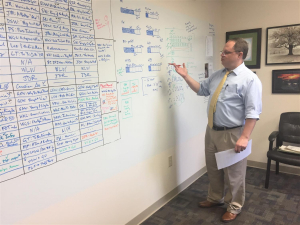By Thomas White, Student at Living Ed – Charlotte
“The world I grew up in was a very different world than the one you’re growing up in.” – Mr. Gerald Weston
As the first semester of the infant Living Education program drew to a close, Mr. Gerald Weston presented us with the opportunity to hear him give an “icebreaker,” a “This is My Life” speech, as he focused the Assembly on an overview of the experiences that have led him to where he is today. In doing so, he emphasized to us the importance of maintaining a strong relationship with our Creator, one built upon fundamental truths that we must diligently prove to ourselves.
Mr. Weston began by reminding us that although he was raised in a “very different world”, it is nonetheless true that, no matter the time period in which we live, “in one sense, we’re all the same. … We grow up, we fall in love, we get married and have children, and eventually, we get old and we die.” I found this quite comforting, as it reminded me that despite the increasing degradation of Satan’s world, God continues to make sure that His people have the same opportunities to grow in the grace and knowledge of Christ. As Mr. Weston made a point of how close the entire planet came to total annihilation during the Cuban Missile Crisis of 1962, it hammered in the humbling realization that God truly does want each of us in His family; were it not for His protection, none of us would be here.
 “Employers don’t pay you what you need; they pay you what you’re worth. … If you want $20 an hour, you probably have to make about $50 an hour for your employer.”
“Employers don’t pay you what you need; they pay you what you’re worth. … If you want $20 an hour, you probably have to make about $50 an hour for your employer.”
As Mr. Weston delved into the background of his parents (“one very pragmatic…and one more of a dreamer”), his childhood (“I moved eleven times in my first thirteen years”), and his experiences in the Worldwide Church of God (“I worked on the custodian crew…and as a proofreader in the letter-answering department”), I was particularly struck by the “awakening” he experienced as a boy living in South Dakota, when he realized that he could be paid for shoveling snow. Armed with only a tiny, fold-up army shovel, he proceeded to make fifty cents by clearing the driveways of neighbors, roughly the equivalent of today’s twenty dollars. He used these experiences to stress that too many entitled individuals believe that they should be paid “what they think they need, as opposed to what they’re worth. … If you provide a service, if you work hard, you don’t have to worry about how much you’re going to get paid.”
“We have to know what our foundation is. Something that’s helped me through difficult times…is to have a strong, internal, mental…spiritual foundation.”
Mr. Weston concluded by telling us how he was able to persevere through the apostasy that wracked the Worldwide Church of God in the ’90s. As he did so, he brought out the importance of keeping our spiritual foundation secure, telling us how crucial it is “to know that God exists…and to know that you know that you know that you know that He exists. [To know] that the Bible is His word…not just a nice book, but it is the word of God, and in its original writings is infallible…to know what it actually says, because when you know what it actually says, from there, with God’s help, you can find where you ought to be.”

What Mr. Weston said shortly thereafter was particularly moving, to me. “You need to have the habit of prayer, study, fasting, meditation. … It’s a constant battle when you get down on your knees to try to pray,” he said, describing how our minds can often be far away from our prayers, even when we’re in the middle of them. “…but you know, what I’ve learned is that if you keep fighting that fight, it will work out. Because maybe you won’t have an effective prayer every single day, but you will have those effective prayers.” As someone who often struggles with keeping his head firmly in his prayers, Mr. Weston’s advice served as both inspiration and encouragement to me.
Mr. Weston summed everything up by quoting the foundational scripture that is Hebrews 11:6, which reads, “But without faith it is impossible to please Him, for he who comes to God must believe that He is, and that He is a rewarder of those who diligently seek Him.” If we can live by this verse, knowing our foundation and diligently maintaining a relationship with God, then, in Mr. Weston’s own words, “I think you’re going to find that life will turn out pretty well for you, just as it certainly has for me, in so many ways.”
*Books mentioned:
“Ike’s Bluff: President Eisenhower’s Secret Battle to Save the World” Evan Thomas

 “Employers don’t pay you what you need; they pay you what you’re worth. … If you want $20 an hour, you probably have to make about $50 an hour for your employer.”
“Employers don’t pay you what you need; they pay you what you’re worth. … If you want $20 an hour, you probably have to make about $50 an hour for your employer.”


